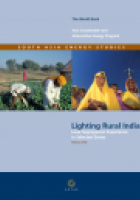Publications
Socioeconomic development of the rural populace is critical to India achieving its stated objective of inclusive growth. It is widely accepted that access to a reliable and sufficient power supply is a key enabler of rural economic growth. Traditionally, India's rural power supply has been restricted by having feeders to villages serve both agriculture and household loads. Because agriculture power supply is rationed by the distribution utilities, residential consumers often suffer from inadequate service. The study findings reveal that segregated systems can be used to manage peak demand, identify and reduce losses previously hidden in agricultural consumption, improve power supply to rural domestic consumers, and bolster socioeconomic development. Enabling the segregated system with information technology (IT) can further improve monitoring and control and bring about transparency and efficiency: Agricultural consumption on which the subsidy is based can be exactly determined, even without consumer metering, and data collected from the system can be used for strategic decision making and operational improvement.
ASTAE (Asia Sustainable and Alternative Energy Program). 2014. Lighting Rural India: Load Segregation Experience in Selected States. South Asia Energy Studies. Washington, DC: World Bank. http://www.esmap.org/sites/default/files/esmap-files/India_Rural%20Feeder%20Segregation%2Cpdf.pdf
